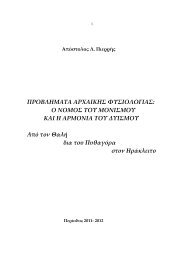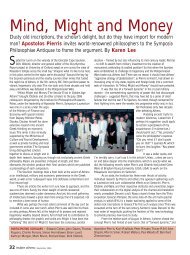chapter 10 the monism of darkness and the dualism of limit and ...
chapter 10 the monism of darkness and the dualism of limit and ...
chapter 10 the monism of darkness and the dualism of limit and ...
Create successful ePaper yourself
Turn your PDF publications into a flip-book with our unique Google optimized e-Paper software.
MONISM OF DARKNESS - DUALISM OF LIMIT AND INDETERMINACY 77<br />
begot Y in Z” (where Z is a locative, in which case <strong>the</strong> formulation<br />
assumes or suggests egg-bearing) which correlates as equivalent to “X<br />
<strong>and</strong> Z (male) gave birth to Y” or even “X gave birth to Y” simply. The<br />
second version exhibits a dualistic tendency, <strong>the</strong> first phrase implies a<br />
potential differentiation between <strong>the</strong>ogonic <strong>and</strong> cosmogonic<br />
sequences, while <strong>the</strong> third insists on a purely matrilinear fa<strong>the</strong>rless<br />
birth. Thus in Acousilaus <strong>the</strong>re are attested three seemingly<br />
incompatible <strong>and</strong> contradictory views on Eros <strong>and</strong> his birth (FGrH 2<br />
F6a-b-c = 9 B1-2-3 DK):<br />
i. According to Plato (Symp. 178 a-b): ÁÔÓÂÖ˜ òEÚˆÙÔ˜ ÔûÙ’ ÂåÛdÓ<br />
ÔûÙ ϤÁÔÓÙ·È ñapple’ Ôé‰ÂÓe˜ ÔûÙ å‰ÈÒÙÔ˘ ÔûÙ appleÔÈËÙÔÜ. Such an<br />
emphatic formulation excludes any normal birth through copulation<br />
<strong>of</strong> a male with female parent <strong>and</strong> ensuing conception. Plato in support<br />
<strong>of</strong> his view refers to Hesiod (Theogony 116-8) <strong>and</strong> Parmenides (28<br />
B13 DK where <strong>the</strong> ruling female Daimon <strong>of</strong> <strong>the</strong> World, <strong>the</strong><br />
Parmenidean Aphrodite<br />
ÚÒÙÈÛÙÔÓ ÌbÓ òEÚˆÙ· ÌËÙ›Û·ÙÔ apple¿ÓÙˆÓ<br />
with no contibution <strong>of</strong> a male parent. This Great Goddess creates<br />
cosmic arrangement by arousing normal sexual attraction <strong>and</strong> causing<br />
intercourse between male <strong>and</strong> female, B 12 DK:<br />
apple¿ÓÙ· ÁaÚ ÛÙ˘ÁÂÚÔÖÔ ÙfiÎÔ˘ ηd Ì›ÍÈÔ˜ ôÚ¯ÂÈ<br />
apple¤ÌappleÔ˘Û’ ôÚÛÂÓÈ ıÉÏ˘ ÌÈÁÉÓ Ùfi Ù’ âÓ·ÓÙ›ÔÓ ·sÙȘ<br />
ôÚÛÂÓ ıËÏ˘Ù¤Úˇˆ).<br />
To <strong>the</strong>se two examples Plato adds Acousilaus: ^HÛÈfi‰ˇˆ ‰b ηd<br />
\AÎÔ˘Û›Ïˆ˜ Û‡ÌÊËÛÈÓ ÌÂÙa Ùe X¿Ô˜ ‰‡Ô ÙÔ‡Ùˆ ÁÂÓ¤Ûı·È, °ÉÓ ÙÂ<br />
ηd òEÚˆÙ·. The meaning is <strong>the</strong> same in all three cases: proper birth<br />
presupposes copulation <strong>of</strong> male with female <strong>and</strong> conception in <strong>the</strong><br />
female. So <strong>the</strong>re is no real parenthood in <strong>the</strong> procreation <strong>of</strong> Eros<br />
according to Hesiod, Acousilaos <strong>and</strong> Parmenides, however <strong>the</strong> exact<br />
formulation <strong>of</strong> this fact may vary.<br />
ii. According to Damascius (De primis principiis 124, I, 320<br />
Ruelle) drawing on Eudemus (Fr. 150 Wehrli), Acousilaus started with<br />
Chaos which was followed by Erebos <strong>and</strong> Nyx âÎ ‰b ÙÔ‡ÙˆÓ Ìȯı¤-<br />
ÓÙˆÓ Aåı¤Ú· ÁÂÓ¤Ûı·È ηd òEÚˆÙ· ηd MÉÙÈÓ... apple·Ú¿ÁÂÈ ‰b âappled ÙÔ‡-<br />
ÙÔȘ âÎ ÙáÓ ·éÙáÓ Î·d ôÏÏˆÓ ıÂáÓ appleÔÏfÓ àÚÈıÌfiÓ.










